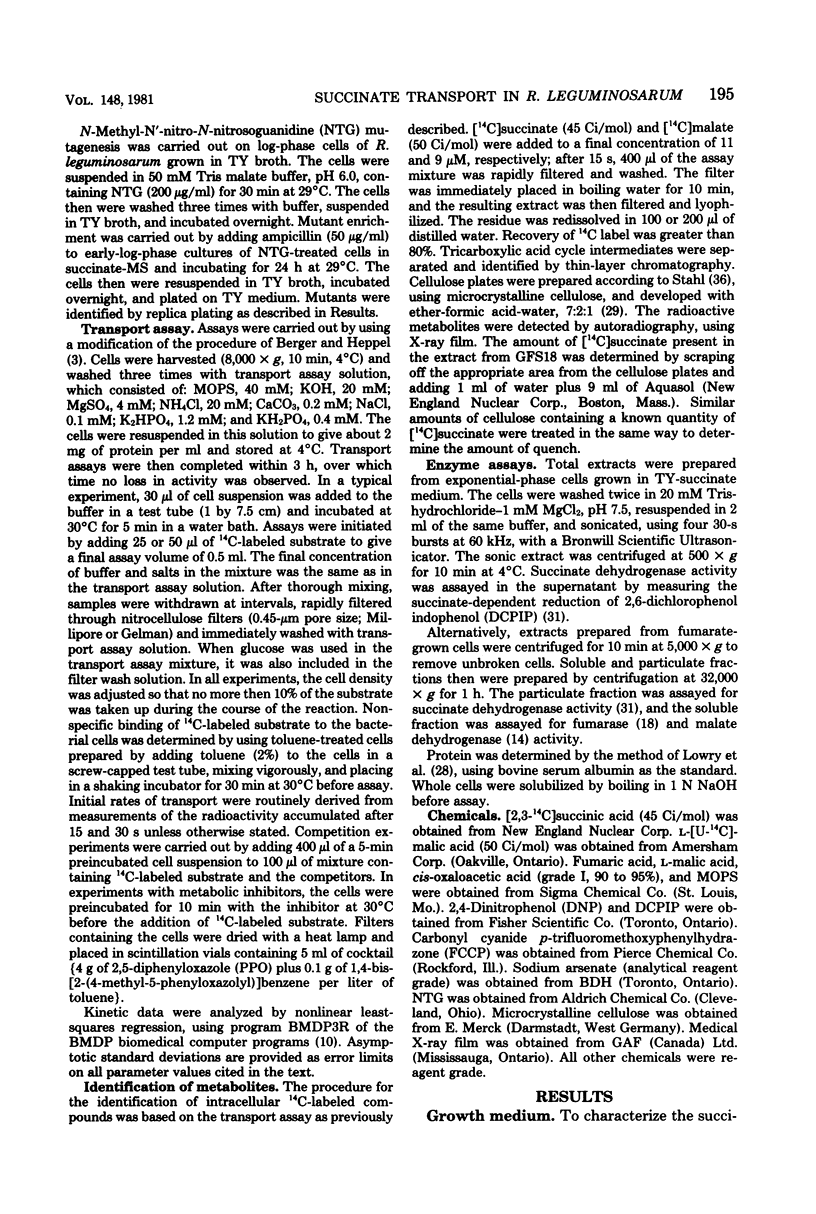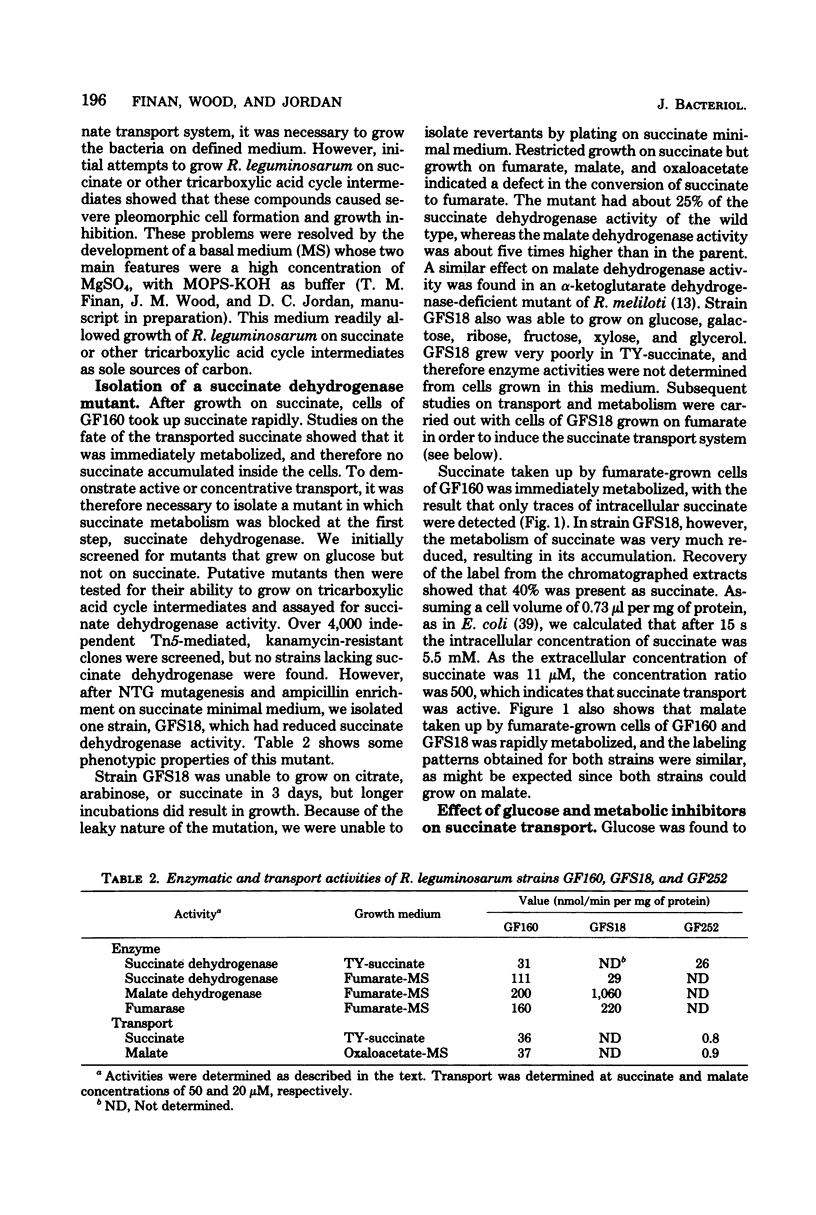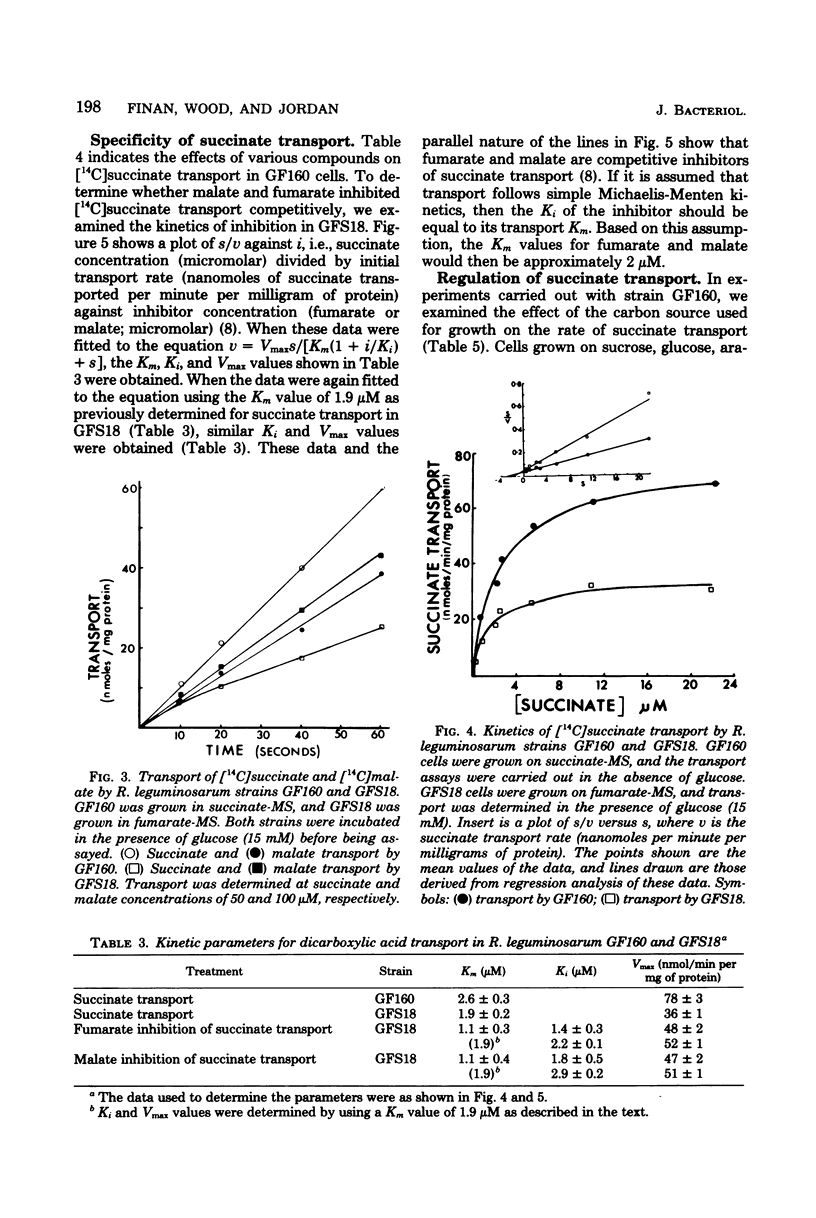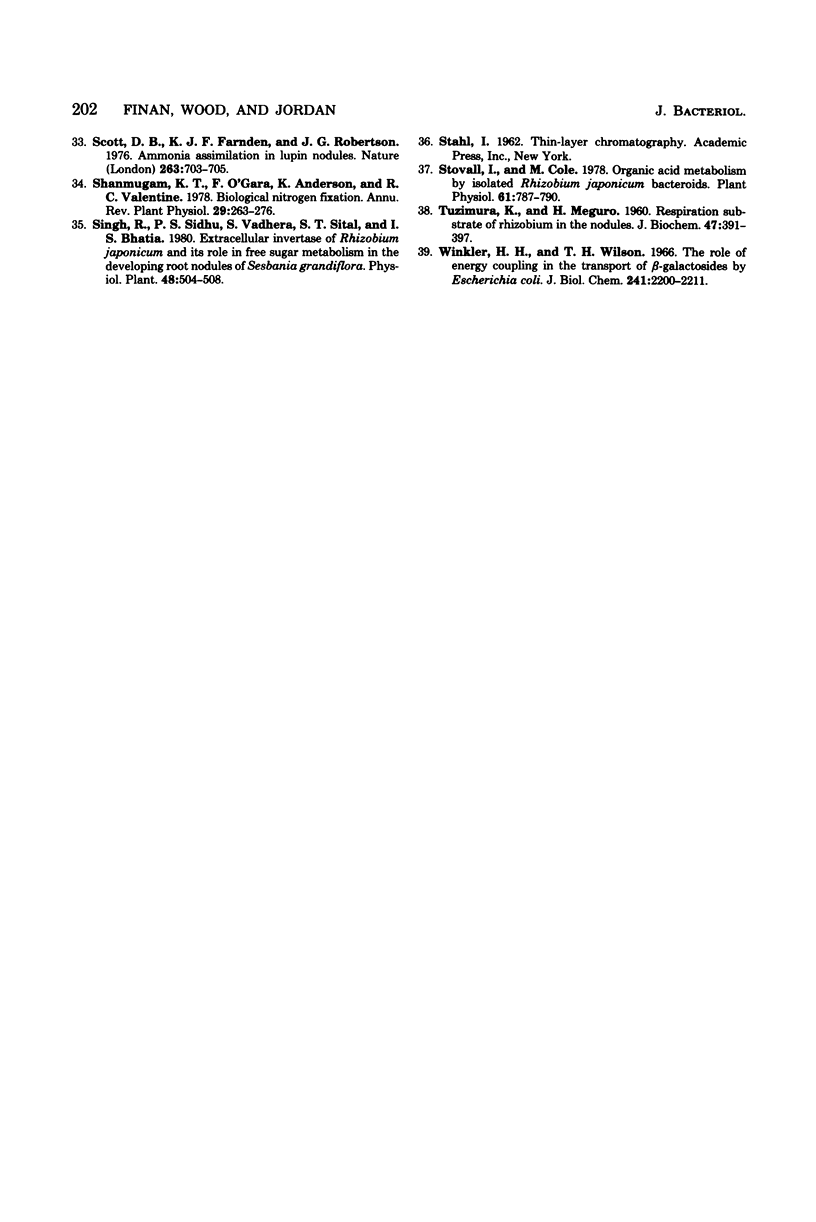Abstract
The transport of succinate was studied in an effective streptomycin-resistant strain of Rhizobium leguminosarum. High levels of succinate transport occurred when cells were grown on succinate, fumarate, or malate, whereas low activity was found when cells were grown on glucose, sucrose, arabinose, or pyruvate as the sole carbon source. Because of the rapid metabolism of succinate after transport into the cells, a succinate dehydrogenase-deficient mutant was isolated in which intracellular succinate accumulated to over 400 times the external concentration. Succinate transport was completely abolished in the presence of metabolic uncouplers but was relatively insensitive to sodium arsenate. Succinate transport was a saturable function of the succinate concentration, and the apparent Km and Vmax values for transport were determined in both the parent and the succinate dehydrogenase mutant. Malate and fumarate competitively inhibited succinate transport, whereas citrate and malonate had no effect. Succinate transport mutants were isolated by transposon (Tn5) mutagenesis. These mutants were unable to transport succinate or malate and were unable to grow on succinate, malate, or fumarate as the sole carbon source. The mutants grew normally on pyruvate, oxaloacetate, citrate, or arabinose, and revertants isolated on succinate minimal medium had regained the ability to grow on malate and fumarate. From these data, we conclude that R. leguminosarum possesses a C4-dicarboxylic acid transport system which is inducible and mediates the active transport of succinate, fumarate, and malate into the cell.
Full text
PDF









Images in this article
Selected References
These references are in PubMed. This may not be the complete list of references from this article.
- Bach M. K., Magee W. E., Burris R. H. Translocation of Photosynthetic Products to Soybean Nodules and Their Role in Nitrogen Fixation. Plant Physiol. 1958 Mar;33(2):118–124. doi: 10.1104/pp.33.2.118. [DOI] [PMC free article] [PubMed] [Google Scholar]
- Berger E. A., Heppel L. A. Different mechanisms of energy coupling for the shock-sensitive and shock-resistant amino acid permeases of Escherichia coli. J Biol Chem. 1974 Dec 25;249(24):7747–7755. [PubMed] [Google Scholar]
- Bergersen J. F., Turner G. L. Nitrogen fixation by the bacteroid fraction of breis of soybean root nodules. Biochim Biophys Acta. 1967 Aug 29;141(3):507–515. doi: 10.1016/0304-4165(67)90179-1. [DOI] [PubMed] [Google Scholar]
- Beringer J. E. R factor transfer in Rhizobium leguminosarum. J Gen Microbiol. 1974 Sep;84(1):188–198. doi: 10.1099/00221287-84-1-188. [DOI] [PubMed] [Google Scholar]
- Cornish-Bowden A. A simple graphical method for determining the inhibition constants of mixed, uncompetitive and non-competitive inhibitors. Biochem J. 1974 Jan;137(1):143–144. doi: 10.1042/bj1370143. [DOI] [PMC free article] [PubMed] [Google Scholar]
- Dubler R. E., Toscano W. A., Jr, Hartline R. A. Transport of succinate by Pseudomonas putida. Arch Biochem Biophys. 1974 Feb;160(2):422–429. doi: 10.1016/0003-9861(74)90416-0. [DOI] [PubMed] [Google Scholar]
- Duncan M. J., Fraenkel D. G. alpha-Ketoglutarate dehydrogenase mutant of Rhizobium meliloti. J Bacteriol. 1979 Jan;137(1):415–419. doi: 10.1128/jb.137.1.415-419.1979. [DOI] [PMC free article] [PubMed] [Google Scholar]
- Ghei O. K., Kay W. W. Properties of an inducible C 4 -dicarboxylic acid transport system in Bacillus subtilis. J Bacteriol. 1973 Apr;114(1):65–79. doi: 10.1128/jb.114.1.65-79.1973. [DOI] [PMC free article] [PubMed] [Google Scholar]
- Jordan D. C., Coulter W. H. On the cytology and synthetic capacities of natural and artificially produced bacteroids of Rhizobium leguminosarum. Can J Microbiol. 1965 Aug;11(4):709–720. doi: 10.1139/m65-094. [DOI] [PubMed] [Google Scholar]
- Kay W. W., Cameron M. J. Transport of C4-dicarboxylic acids in salmonella typhimurium. Arch Biochem Biophys. 1978 Sep;190(1):281–289. doi: 10.1016/0003-9861(78)90277-1. [DOI] [PubMed] [Google Scholar]
- Kay W. W., Kornberg H. L. The uptake of C4-dicarboxylic acids by Escherichia coli. Eur J Biochem. 1971 Jan;18(2):274–281. doi: 10.1111/j.1432-1033.1971.tb01240.x. [DOI] [PubMed] [Google Scholar]
- Kidby D. K. Activation of a plant invertase by inorganic phosphate. Plant Physiol. 1966 Sep;41(7):1139–1144. doi: 10.1104/pp.41.7.1139. [DOI] [PMC free article] [PubMed] [Google Scholar]
- Kurz W. G., LaRUE T. A. Citric acid cycle enzymes and nitrogenase in nodules of Pisum sativum. Can J Microbiol. 1977 Sep;23(9):1197–1200. doi: 10.1139/m77-180. [DOI] [PubMed] [Google Scholar]
- LOWRY O. H., ROSEBROUGH N. J., FARR A. L., RANDALL R. J. Protein measurement with the Folin phenol reagent. J Biol Chem. 1951 Nov;193(1):265–275. [PubMed] [Google Scholar]
- Lo T. C., Rayman M. K., Sanwal B. D. Transport of succinate in Escherichia coli. I. Biochemical and genetic studies of transport in whole cells. J Biol Chem. 1972 Oct 10;247(19):6323–6331. [PubMed] [Google Scholar]
- Lo T. C., Sanwal B. D. Isolation of the soluble substrate recognition component of the dicarboxylate transport system of Escherichia coli. J Biol Chem. 1975 Feb 25;250(4):1600–1602. [PubMed] [Google Scholar]
- Myers W. F., Huang K. Y. Separation of intermediates of the citric acid cycle and related compounds by thin-layer chromatography. Anal Biochem. 1966 Nov;17(2):210–213. doi: 10.1016/0003-2697(66)90199-0. [DOI] [PubMed] [Google Scholar]
- Stovall I., Cole M. Organic Acid Metabolism by Isolated Rhizobium japonicum Bacteroids. Plant Physiol. 1978 May;61(5):787–790. doi: 10.1104/pp.61.5.787. [DOI] [PMC free article] [PubMed] [Google Scholar]
- Winkler H. H., Wilson T. H. The role of energy coupling in the transport of beta-galactosides by Escherichia coli. J Biol Chem. 1966 May 25;241(10):2200–2211. [PubMed] [Google Scholar]



